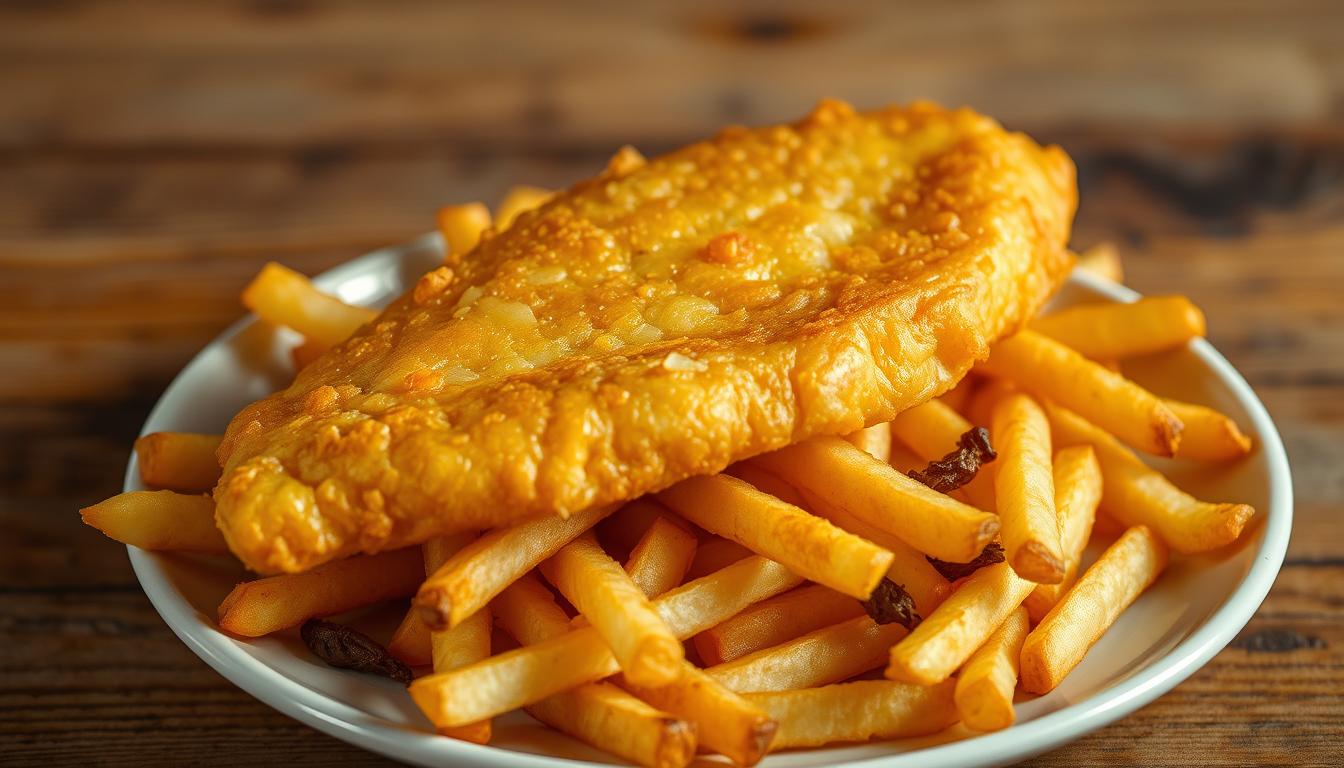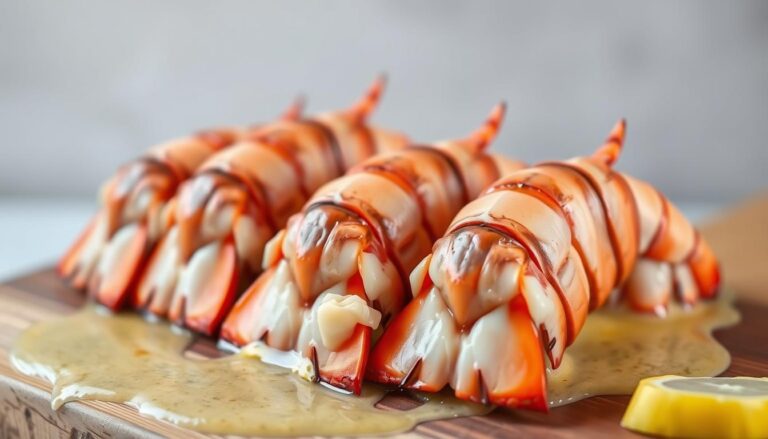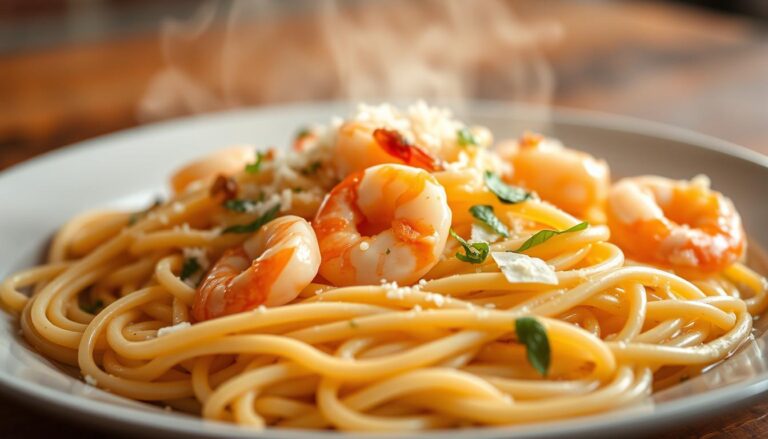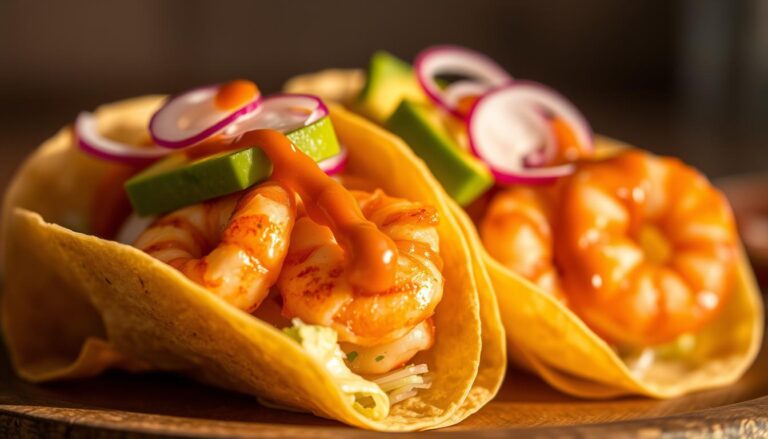There’s something undeniably comforting about biting into a perfectly cooked piece of Crispy Fish and Chips Recipe coated in a golden, crispy batter, served alongside a plate of hot, salty chips. For me, this dish brings back memories of seaside vacations and cozy nights in. The best part? You don’t need to be a skilled chef to recreate this classic at home.
I’ve perfected my batter recipe to achieve that ideal balance of crispiness on the outside and tender, flaky fish on the inside. With a few simple ingredients and some straightforward steps, you can enjoy restaurant-quality fish and chips in the comfort of your own home.
Key Takeaways
- Learn how to make a crispy batter for your fish.
- Discover the secrets to achieving perfectly cooked fish.
- Find out how to make delicious, homemade chips.
- Get tips on selecting the right type of fish for your recipe.
- Understand how to recreate a classic comfort food dish at home.
The Perfect Homemade Fish and Chips
The allure of fish and chips lies in its simplicity and the joy it brings, and I’m about to show you how to recreate this dish in your own kitchen. For many, it’s a nostalgic experience that evokes memories of seaside trips and cozy nights in.
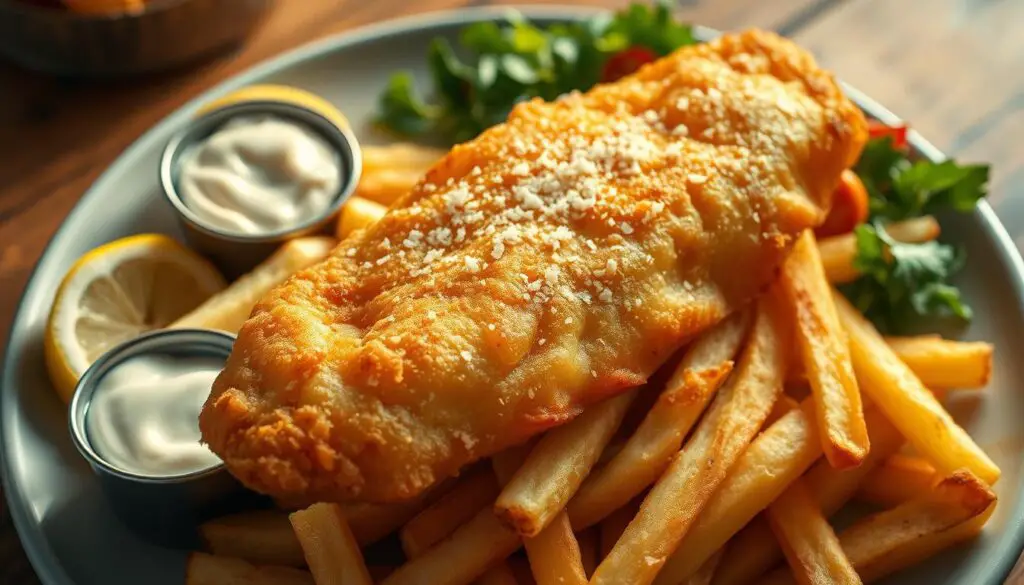
Why This Recipe Works
My fish chips recipe is designed to deliver that authentic taste and texture that makes this dish so beloved worldwide. The key lies in using fresh ingredients and a special batter that crisps up perfectly when fried.
Using fresh cod, a staple in Newfoundland cooking, ensures that the fish is tender and flaky on the inside while crispy on the outside.
What Makes Traditional Fish and Chips Special
Traditional fish and chips has a rich history dating back to the 1860s in England. The combination of crispy battered fish with thick-cut chips creates a perfect balance of textures and flavors. What makes it special is the contrast between the crispy exterior and the tender, flaky fish inside, complemented by malt vinegar, lemon, and tartar sauce.
By following this recipe, you’ll be able to achieve that authentic taste and enjoy one of the world’s favorite comfort foods in the comfort of your own home, exploring various recipes to make it your own.
Essential Ingredients for Crispy Fish and Chips Recipe
To achieve that irresistible crispy fish and chips, you’ll need to focus on the essentials. The quality of your ingredients plays a significant role in the final outcome, from the flakiness of the fish to the crunch of the chips.
Selecting the Best Fish
For an authentic fish and chips experience, choosing the right fish is crucial. I recommend using cod or haddock for their flaky texture and mild flavor. The freshness of the fish is paramount, so opt for sustainable, fresh catches whenever possible.
The Secret to a Crispy Batter
The batter is what gives fish and chips its signature crunch. To achieve this, I use a mixture that includes all-purpose flour, cornstarch, and a leavening agent like baking powder. The addition of cold beer or soda water helps in creating a light, airy batter that fries up crispy. The key is to not overmix the batter, as this can lead to a dense coating.
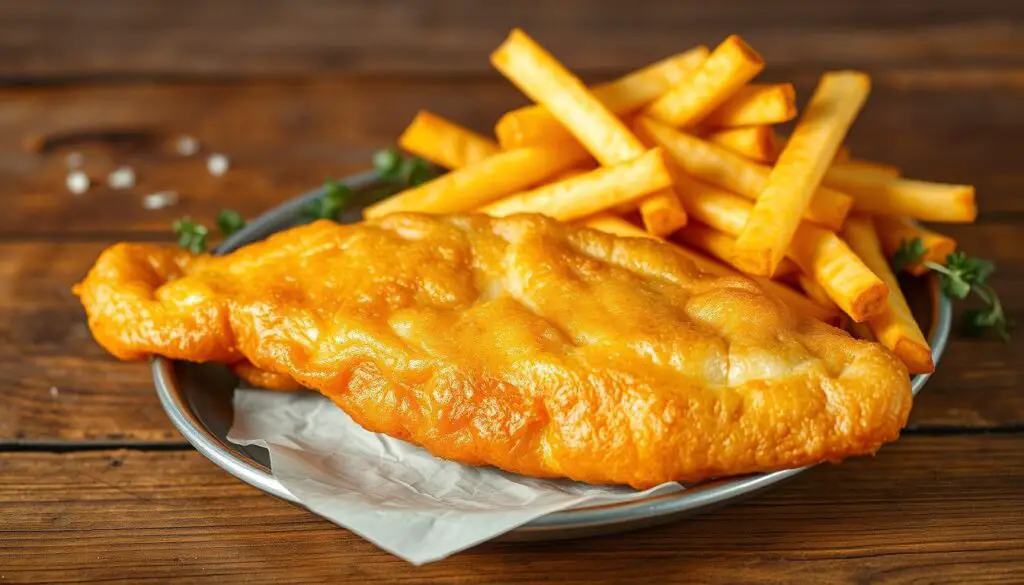
Preparing Perfect Chips
For the chips, or fries, I recommend using starchy potatoes like Russets or Idaho. Cutting them into thick batons (about ½-inch thick) is ideal for authentic British-style chips. Soaking the cut potatoes in cold water for 30 minutes removes excess starch, helping achieve crispier results. You can fry them in hot oil using the double-frying method for the best texture, or opt for a healthier alternative by baking or using an air fryer.
Whether you choose to deep-fry or bake your chips, the right ingredients and technique will ensure a delicious accompaniment to your crispy fish. With these essentials, you’ll be well on your way to creating a classic fish and chips dish that’s sure to please.
Step-by-Step Cooking Instructions
The key to perfect fish and chips lies in the cooking technique. To achieve that crispy exterior and tender interior, we need to follow a precise cooking process.
Preparing the Fish
First, we need to prepare our fish for frying. I use fresh cod fillets, cut into manageable pieces. Pat the fish dry with paper towels to remove excess moisture, which helps the batter adhere better. Season the fish with salt and a pinch of pepper to enhance the flavor.
Making the Perfect Batter
To make the batter, I combine flour, cornstarch, and a bit of baking powder in a bowl. The addition of cornstarch helps in achieving a lighter, crisper coating. Gradually add cold beer or soda water, whisking until the batter is smooth and free of lumps. The batter should still be slightly lumpy for the best results.
Frying the Fish to Golden Perfection
Heat oil in a deep fryer or a large pot to the right temperature. For frying fish, the ideal temperature is around 350°F (175°C). Carefully place the battered fish into the hot oil, frying until it’s golden brown and crispy. This usually takes about 3-4 minutes per side. Use a thermometer to maintain the correct oil temperature.
Cooking the Chips
For the chips, I use the double-frying method for the best texture. First, I fry the potato batons at a lower temperature (325°F or 165°C) for about 5 minutes until they’re soft but not browned. After draining on paper towels, I let them rest before increasing the oil temperature to 375°F (190°C) for the second fry, until they become golden brown and crispy. This two-stage process ensures chips that are fluffy inside and crispy outside, perfect to accompany the battered fish. You can also make fries using the same pot of hot oil or opt for baked or air-fried alternatives.
Pro Tips for Restaurant-Quality Results
Making exceptional fish and chips isn’t just about the ingredients; it’s also about the technique. To achieve that perfect, restaurant-quality dish at home, consider these expert tips.
Maintaining the Right Oil Temperature
One crucial factor is maintaining the right oil temperature. If the oil is too hot, the outside will burn before the inside is fully cooked. Too cold, and the fried fish will absorb too much oil, becoming greasy. Use a thermometer to keep the oil at the optimal temperature.
Preventing Soggy Batter
To prevent soggy batter, it’s essential to not overcrowd the pot when frying. Fry in batches if necessary, to ensure each piece has enough room to cook evenly. After frying, place the cooked fillets on paper towels to drain excess oil.
Timing and Serving Suggestions
Serving at the right time is crucial. I always prepare my serving area before starting to cook, having plates lined with paper towels and sauces ready. Start the chips first, then prepare and fry the fish, finishing with the second fry of the chips. To keep the cooked fish warm, you can place it in a oven set at 200°F (95°C). Serve immediately with traditional accompaniments like malt vinegar and homemade tartar sauce.
By following these tips, you’ll be able to enjoy restaurant-quality fish and chips in the comfort of your own home, all while managing the time effectively to ensure a delightful dining experience.
Delicious Variations and Serving Ideas
If you’re looking to shake up your fish and chips routine, I’ve got some great alternatives to share. Whether you’re in the mood for a different cooking method or want to try new accompaniments, there’s something here for everyone.
Alternative Cooking Methods
For a healthier take on the classic, consider using an air fryer for your fish and chips. This method uses less oil and can produce a crispy exterior and tender interior, similar to deep-frying.
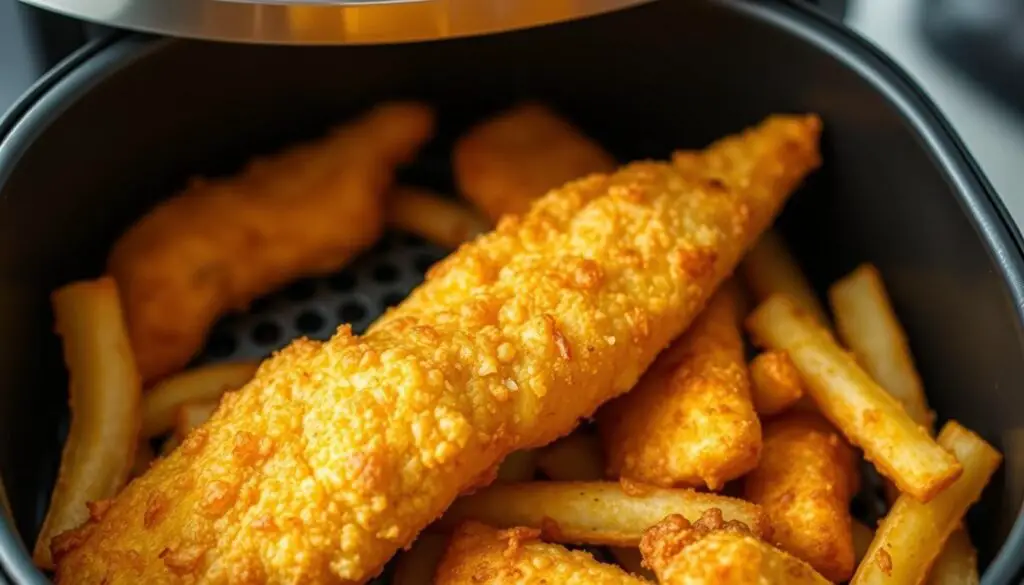
Homemade Tartar Sauce and Accompaniments
Elevate your fish and chips with a homemade tartar sauce. My recipe combines 1 cup of mayonnaise, 2 tablespoons of finely chopped pickles, 1 tablespoon of capers, 1 tablespoon of lemon juice, and 1 teaspoon each of fresh dill and parsley. For an added twist, try a lime and caper tartar sauce made with 1 cup plain mayonnaise, 2 tsp capers, 2 tsp sweet pickle relish, 1 tsp honey, 1 tsp Worcestershire sauce, juice of 1/2 lime, 1 tsp lime zest, and a pinch of black pepper.
Traditional British accompaniments include malt vinegar, lemon wedges, and mushy peas. In the American South, coleslaw and hushpuppies are a delicious fusion. For a complete meal, serve with a simple side salad dressed with vinaigrette.
Conclusion
Making authentic fish and chips at home is not only achievable but also incredibly rewarding, and I’m excited for you to try it out. With the techniques and tips shared, you’ll be able to create a crispy exterior and tender, flaky fish interior that rivals any restaurant. Don’t be intimidated by deep frying; with proper temperature control and the right batter, you’ll achieve crispy fish and chips that are perfect for family dinners or casual entertaining.
To enjoy your fish chips at their best, serve them fresh. If you have leftovers, you can store them in an airtight container in the refrigerator and reheat them in the air fryer at 380 degrees until crispy. You can also freeze the fried fish fillets for up to 2 months and reheat them in the air fryer for a quick meal. I encourage you to try this recipe and experience the satisfaction of serving homemade fish and chips that are sure to become a favorite.

